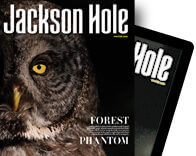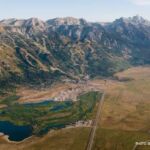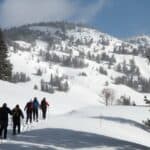Read The
Current Issue
Revived & Revered
Thanks to efforts of Indigenous wildlife managers, the Wind River Reservation is again an ecologically vibrant and crucial piece of the Greater Yellowstone Ecosystem.
// By Mike Koshmrl

During one of the most sordid, shameful incidents Richard Baldes remembers, a herd of the Wind River Indian Reservation’s scant pronghorn became pinned against the low-elevation highway by deep snow. They had nowhere to go.
It was the winter of 1978–1979, one of the worst on record. These animals might have faced a long and slow death anyway. Mass starvation is often the outcome of severe Wyoming winters, and it’s driven the ebbs and flows of populations of species like pronghorn and mule deer for thousands of years. But these ungulates were dwelling on the reservation in the era before there was a Tribal game code, and they were relentlessly pursued—even in the depths of a terrible winter.
“Antelope were balling up against fences along the highway,” recalls Baldes, an Eastern Shoshone member who was then working as a biologist for the U.S. Fish & Wildlife Service. “People were killing them, right in front of everybody’s eyes. It was not a good thing. The animals didn’t have a chance; they were just trying to survive.” The incident was so ugly it attracted publicity in The New York Times. Down the highway in Lander, Tom Dougherty was directing the Wyoming Wildlife Federation at the time. He gave an interview to the Times about the ignoble slaughter that had attracted eyeballs around the country. “I told them the only regulatory feature on the Wind River Indian Reservation is the cost of gasoline and ammunition,” Doughtery says. “That was true then.”
It was an era of lawlessness and emptiness on the Eastern Shoshone and Northern Arapaho’s reservation, a spectacular 2.2-million-acre expanse that unfurls off of the east slope of the Wind River Range, home to Wyoming’s highest peaks. Fortunately, that’s no longer the case—far from it. Today, the Wind River Reservation has a nearly full complement of native megafauna: there are healthy herds of pronghorn, elk, whitetail, and mule deer numbering in the thousands. (Only bison are still missing; see the sidebar.)
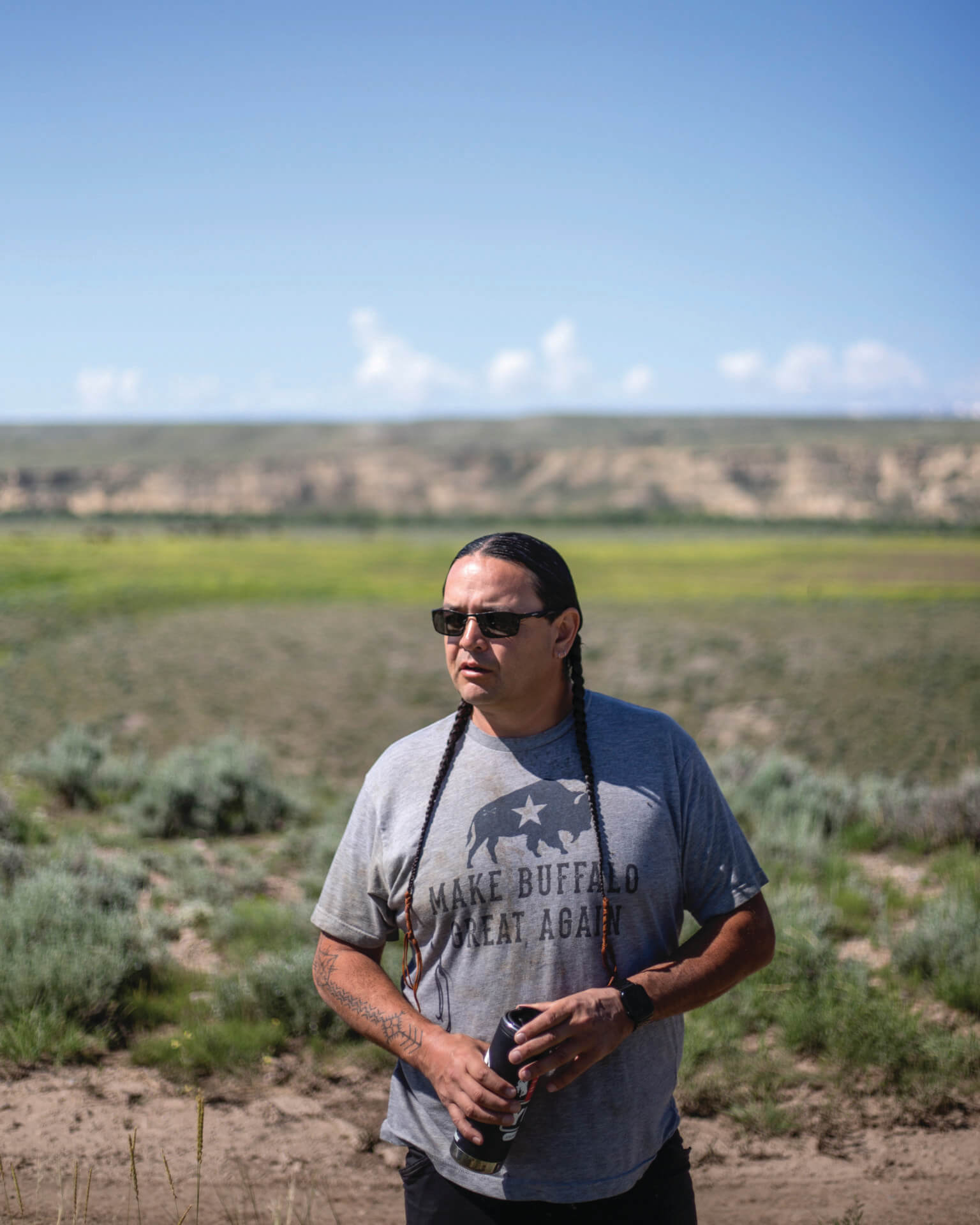

After being wiped out entirely, large carnivores like wolves and grizzly bears have also staged a comeback and returned to their niche in the ecosystem. An ecological crisis caused by free-roaming horses breeding out of control and decimating the rangeland has also largely been solved by rounding up the thousands of nonnative equines. Taken altogether, the intact assemblage of wildlife thriving on a vast landscape is so rare and impressive that it’s drawn comparisons to a similar-sized northwest-Wyoming preserve. “There’s no question that the habitat [on the reservation] is equal to or better than Yellowstone,” Doughtery says. “If the Tribes and the custodians of wildlife are there, it will be the next Yellowstone National Park from a wildlife perspective.”
The remarkable turnaround on the Wind River Reservation took decades. Baldes, now 83, was in the thick of it all. The University of Wyoming-trained biologist did stints with the Wyoming Game & Fish Department; the Montana Department of Fish, Wildlife, and Parks; and the U.S. Fish & Wildlife Service in Arizona. Staying on with the federal government at the Fish & Wildlife Service, he returned to the central Wyoming reservation where he was raised in 1972. There wasn’t much wildlife around to manage. Nowadays, a herd of about 50 pronghorn spend part of each summer on Baldes’s property to the west of Fort Washakie, one of a handful of small towns on the reservation. In his youth, there were zero. “As a matter of fact, when my dad used to go antelope hunting, we’d hunt south of Riverton because there weren’t any antelope here to hunt,” he says. Game populations just couldn’t withstand unregulated pressure from modern human hunters. “If you have to make your own arrows, make your own arrowheads, and hunt with a bow, then you can have unregulated hunting,” Baldes says. “But if you’re using vehicles, snowmachines, high-powered rifles, spotting scopes, all that gear, that can’t happen anymore.”
Today, a herd of about 50 pronghorn spend part of each summer on Baldes’s property to the west of Fort Washakie, one of a handful of small towns on the reservation.
Baldes got to work on developing a game code, though his planning and dealings were often unfolding in the background. To make it happen, he’d have to bring both the Eastern Shoshone and Northern Arapaho Tribes on board. Forced to share the reservation since 1878, the two Tribes didn’t always get along. Baldes is an Eastern Shoshone member. Imposing hunting, fishing, and trapping seasons on residents who weren’t accustomed to and didn’t want them wasn’t easy. “I became a pretty big enemy, especially of the [Northern] Arapaho Tribe,” Baldes says. The fight was pitched enough that one day he returned from a fishing trip to discover bullets had torn holes through the walls of his family’s trailer.

Remarkable Return
Although the code was drafted in 1979, the Northern Arapaho wouldn’t vote to implement it. A federal court eventually arbitrated a solution, putting the game code into effect in 1984. “In a sense, they were forced into it,” Baldes says. Wildlife finally got a reprieve after decades of unregulated killing. Initially, there weren’t many animals around to benefit. But Baldes and the Tribes almost immediately began transplanting pronghorn and bighorn sheep, species that had been functionally extirpated from the reservation. Elk and mule deer were still present enough that they bounced back on their own. “It didn’t take long for those antelope to thrive and do their thing.” Baldes says. “They had the best habitat in the world that hadn’t been occupied for 50, 80, 100 years.”
Initially, hunting wasn’t allowed at all in order to give the herds time to grow back. By the early 1990s, the tides had turned and the native ungulate herds were once again abundant. “‘You said it was going to take 10 years,’” Jason Baldes, Richard’s son, remembers telling his father. “I killed my first antelope eight years later, because the population had grown to a level that was sufficient for harvest.” Richard Baldes agrees the herds bounced back with impressive speed. “When we go out and hunt an antelope, it’s not unusual for us to see 400 or 500 head in the morning of one hunt—in one day,” he says. “We went from nothing to that.”
Today, the Wind River Indian Reservation is chock full of native ungulates and large carnivores. It’s also an extraordinary place to be a human hunter. Art Lawson, who directs Shoshone and Arapaho Fish & Game and manages wildlife on the reservation, likes to say there’s an argument that Tribal members have the best hunting opportunities of anywhere in the Lower 48 states. Partly that’s just because of the lack of pressure. There are roughly 13,000 members between the Northern Arapaho (approximately 9,000) and Eastern Shoshone (approximately 4,000) Tribes, and they have no one to compete with but themselves for access to the game that dwells on an area the size of Yellowstone. (Non Tribal members are eligible to fish on the reservation with a permit but cannot hunt.) “You can fill your freezer with elk, deer, antelope, and you can draw for moose and bighorn sheep,” Jason Baldes says. “It’s the best hunting opportunity there is in the world.”
A prion disease related to mad cow disease is now found in more than 60 percent of the population of the Tribe’s project herd of deer; this is the highest prevalence rate of the disease anywhere in Wyoming.
Toothy critters balance out the predator-prey dynamics, too. Wolves were extirpated from the Yellowstone region, including the reservation, during the Anglo settlement era, only to be reintroduced in the 1990s. Canis lupus made its way south from Yellowstone National Park to the Eastern Shoshone and Northern Arapaho’s modern territory almost immediately, with packs establishing along the front of the Winds and Owl Creek Mountains—a welcomed return of a species the Tribes regard “as kin, as helpers, as strong [and] deserving of respect,” according to the wolf management plan for the reservation. Grizzly bears, likewise, were extirpated from the Winds, only to return as a result of the Endangered Species Act and deliberate conservation efforts.
The Tribes manage grizzlies differently than elsewhere. In 2023, a bold grizzly bear was frequenting campsites in the high-elevation portion of the reservation popular with Wind River Range backpackers. Rather than wait for a bad run-in to happen, the Tribal councils closed down an entire drainage to human use, acting on a recommendation from Lawson, the Tribal Fish & Game chief. The precautionary measure and attempt at coexistence seemed to work. No more issues were reported with the grizzly bear that summer.
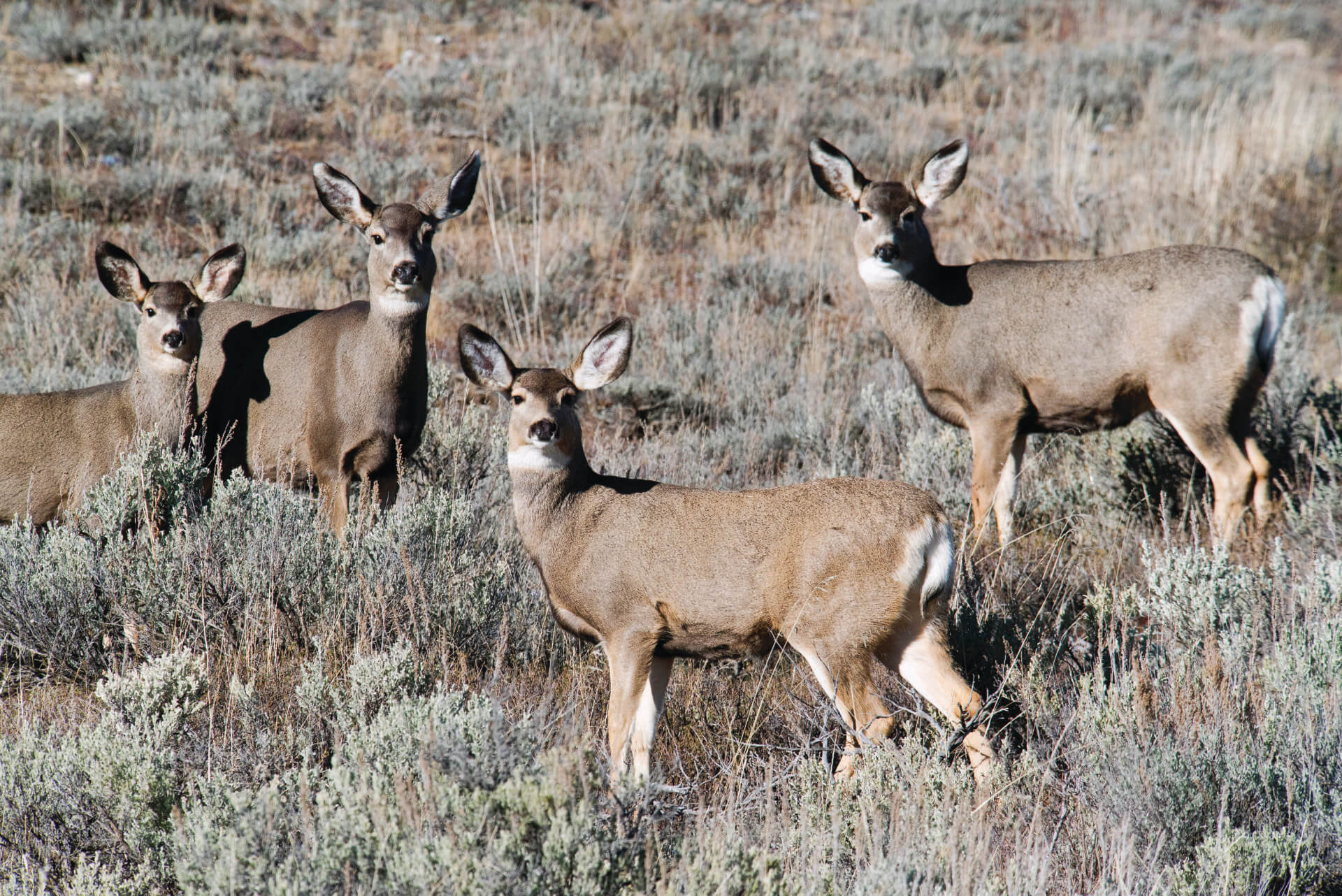

Modern Challenges
Although the Wind River Reservation’s fauna have enjoyed a 180-degree turnaround since the pre-game-code lawlessness of the early-to-mid-20th century, its wildlife face modern threats and challenges. A population of free-roaming horses exploded in the Wind River Valley in recent decades, reaching a high point of nearly 10,000 animals. The non-native equines, which have no real predators, effectively displaced the native species from the rangeland by eating them out of a home. The situation was dire enough that Pat Hnilicka, a U.S. Fish & Wildlife Service biologist based in Lander, dubbed it an “ecological crisis.” The horses were eating more than 100 million pounds of forage annually, often leaving only non-native cheatgrass remaining on the range. But over the last couple years, roughly 7,600 horses were gathered and trucked away. The landscape immediately took a breath. “We used to drive around and see horses,” Lawson said during a June 2024 drive around the reservation. “Now we can drive around and see wildlife. The mule deer that I’ve seen since we removed horses is unreal—really, deer [numbers] I haven’t seen in 10 years.”
Yet, mule deer here have another difficulty. The herd dwelling in the core of the reservation, known as the Project Herd, is a poster child of how chronic wasting disease can devastate a population of ungulates. That prion disease, an always-lethal cousin of mad cow disease, is being found in more than 60 percent of the Project Herd’s deer—the highest prevalence rate of anywhere in Wyoming. Because animals are dying before they can breed and replace themselves, the herd is declining. “Deer, they are in trouble now,” Richard Baldes says. With few proven tools to fight chronic wasting disease, the future of mule deer on the reservation is unclear.
On the upside, at least there are mule deer—and elk, pronghorn, and the remaining suite of native species—to fight for. It’s a testament to the decades of effort that Richard Baldes and his counterparts put into establishing a game code and then diligently growing back and managing big game herds. “It’s because of Richard Baldes that it’s now a vibrant ecological community,” says Dougherty, the former Wyoming Wildlife Federation executive director. “I attribute it—all of it, in reality—to Richard. He had the biological knowledge, and he stuck to it long enough to fight [the game code] through. Now, everybody is proud of what has happened: the return of quantities and quality of wildlife on the Wind River Indian Reservation.”

A Boost for Bison
The next generation of Baldeses fights to restore buffalo to Wind River.
Biologist Jason Baldes, who leads the Wind River Tribal Buffalo Initiative, had a big 2024. An Eastern Shoshone Tribal member and the son of Richard Baldes, he was awarded a National Geographic Wayfinder Award and made major progress toward achieving his ultimate goal of restoring bison as a free-roaming wildlife species on the Wind River Reservation. Through the Economic Development Administration’s “recompete” grant program, Baldes was awarded nearly $10 million to build a new 14,000-square-foot buffalo museum. The facility, which hasn’t been built yet, is projected to support 15 full-time and six part-time jobs in one of the most impoverished areas of Wyoming.
The cause of bison restoration also got a boost. Baldes has acquired new grazing land to grow the Northern Arapaho and Eastern Shoshone’s fenced herds. He’s stepped up his lobbying efforts, too, in hopes of reclassifying bison as wildlife under the Tribal game code his father pioneered. “I met with the Wind River ag producers a couple weeks ago,” Baldes said in late fall 2024. “It was a meeting that I’ve been very hesitant to have because of the perceived animosity against buffalo that’s out there from cattle producers—whether they’re Tribal or not.” Baldes’s plan is to give stock-growers financial incentive to give up their grazing allotments, then turn bison loose in the same spots.
The endeavor has potential to take decades, not unlike his father’s push to create a Tribal game code in the 1970s and ’80s. “Jason has been a singular champion for buffalo restoration, helping to restore an iconic animal once on the brink of extinction while centering Tribal and Indigenous priorities,” says Brian Kurzel, executive director of the National Wildlife Federation’s Rocky Mountain Regional Center. “This award [from the National Geographic Society] could not be more well-deserved.” JH
